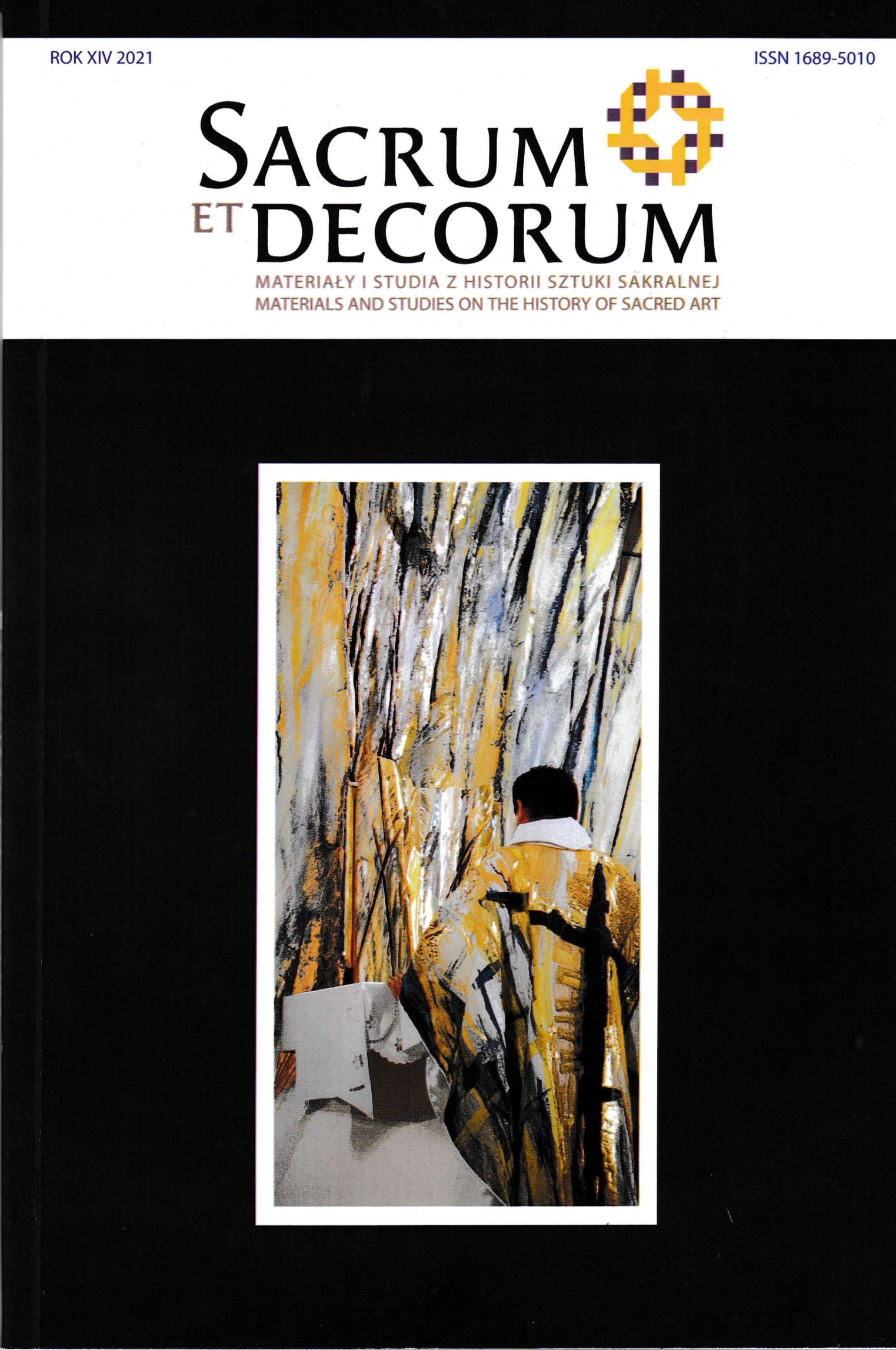Brąz i szkło w symbolice przestrzeni granicznej. Między sacrum wnętrza świątyni chrześcijańskiej a zewnętrznym profanum
DOI:
https://doi.org/10.15584/setde.2021.14.4Słowa kluczowe:
drzwi z brązu, witraż, przestrzeń graniczna, strefa wejścia, przenikanie przestrzeniAbstrakt
Brąz i szkło to materiały, które od wieków były wykorzystywane w wystroju świątyni chrześcijańskiej jako nośniki znaczeń symbolicznych. Gdy w elewacji frontowej kościoła znajdowały się rzeźbione drzwi z brązu, a okno umieszczone na osi powyżej było przeszklone, często wypełnione witrażami, następowało symboliczne przeciwstawienie materiału i koloru: rzeźbionego brązu drzwi w ziemskiej strefie profanum i umieszczanych powyżej szklanych barwnych obrazów symbolizujących sacrum. W artykule przytoczono przykłady wskazujące na poszukiwania nowych form ekspresji i kształtowanie się nowej symboliki związanej z metalem i szkłem we współczesnej sztuce sakralnej. Zmiany polegają na wprowadzeniu koloru do dekoracji drzwi z brązu, szklanych inkrustacji oraz stopniowej dominacji dużych tafli szkła. Często ekspresję szkła zaczynają dopełniać formy utworzone za pomocą nowych technik operowania sztucznym światłem. Poszukiwania twórców niejednokrotnie prowadzą do rozbudowania wejścia do świątyni, włączenia różnych form instalacji, coraz częściej kierują się też w stronę wykorzystania nowych mediów. Współczesnych artystów inspiruje w dużej mierze stanowisko Kościoła, podkreślającego znaczenie przestrzeni granicznej między sacrum i profanum, a w konsekwencji coraz częściej odwołującego się do symboliki drzwi i patronującego kolejnym nowatorskim rozwiązaniom.Downloads
Bibliografia
Apa M., Unità e crisi del racconto. La porta nel XX secolo, https://www.koinemagazine.it/edilizia-di-culto/unita-e-crisi-del-racconto-la-porta-nel-xx-secolo.
Armando Marrocco. Pregare col bronzo, wstęp: P. Restany, Cinisello Balsamo, 2000.
Botta M., Chiesa a Seriate: Centro pastorale Giovanni 23, Milano 2004.
Brama Trzeciego Tysiąclecia we Wrocławiu, www.architeon.pl/index.php/wiadomosci/projekty/240-brama-trzeciego-tysiaclecia-we-wroclawiu.html
Braun H., Andreas Horlitz – Transposition, „Das Münster” 2015, nr 3, s. 216–219.
Franciszek, Misericordiae vultus,franciszek_i/bulle/misericordiae-lev_11042015.html.
Hani J., Symbolika świątyni chrześcijańskiej, tłum. A. Lavique, Kraków 1998.
Jan Paweł II, Aperite portas Redemptori, http://lp33.de/strona-lp33/ind8.htm
Jan Paweł II, Incarnationis Mysterium, http://lp33.de/strona-lp33/ind8.htm
Królikowski J., Pierwotne kształtowanie się symboliki drzwi za pośrednictwem niektórych ich realizacji, w: Fides ex visu. U drzwi twoich, red. R. Knapiński, A. Kramiszewska, Lublin 2013, s. 39–48.
„La Porta del cielo” di Walter Valentini – Urbino, http://www.laprimaweb.it/2010/06/15/porta-cielo-walter-valentini-urbino
Mauriac F., Semino M., La Porta del cielo di Lello Scorzelli in San Pietro a Portovenere, Roma 1993.
Motyka A., Katedra rzeszowska, w: Encyklopedia Rzeszowa, red. J. Draus i in., Rzeszów 2004, s. 216–217.
Niccolai L., La chiesa della Trasfigurazione a San Miniato Basso. Note storiche, artistiche e liturgiche, San Miniato 2019.
Nuova bussola d’ingresso della Chiesa di Santissimo Nome di Maria, https://www.ssnomemaria.it/la-bussola-di-ingresso/15-l-inaugurazione-della-porta.htm
Pais P., La fede fatta arte nell’opera di Suor Angelica Ballan, Voce Serafica, Maj 2009, https://www.voceserafica.it/articolo.asp?ID=1436&idmagazine=2009005
Pousse J.F., Lieux de culte et création architecturale contemporaine, „Arts Sacrés” 2014, nr 31, s. 45.
Przekroczyć próg nadziei. Jan Paweł II odpowiada na pytania Vittoria Messoriego, Lublin 1994.
Puig I., Tarrech A., Las puertas de la basilica de la Sagrada Familia de Barcelona, „Anuario de Historia de la Iglesia” XXII, 2013, s. 235–255.
Ryba G., Między historią a teologią. Kościół bernardynów w Rzeszowie. Mistagogia przestrzeni prowadzącej do wnętrza świątyni, „Folia Historica Cracoviensia” XXII, 2016, s. 393–412.
Ryba G., Na granicy rzeczywistości. Mistyk, droga poznania mistycznego i artysta współczesny, w: Fides ex visu. Okiem mistyka, red. A. Kramiszewska, Lublin 2012, s. 249–255.
Ryba G., Oświęcimskie drzwi z brązu. Przyczynek do ikonografii św. Maksymiliana Kolbe, w: Limen expectationis. Księga ku czci śp. ks. prof. dr. hab. Zdzisława Klisia, red. ks. J. Urban, ks. A. Witko, Kraków 2012, s. 299–310.
Salvini Ch., La chiesa di San Pietro sul Promontorio di Portovenere, http://www.neldeliriononeromaisola.it/2021/01/347214/
Santuario di Sacro Cuore di Gesù. Un convegno e il comletamentto, „Corriere Adriatico” nr 42, 16 XI 2016, s. 2.
Steiner P.B., Kirche über den Tod hinaus, „Das Münster” 2016, nr 1, s. 62.
Struck M., Relaunch Wegenkirche, „Das Münster” 2012, nr 1, s. 28–31.
Terrin A.N., La porta e il passare attraverso la porta. Un simbolo cultuale e spaziale di cambiamento e di trasformazione nella storia delle religioni, „Rivista Liturgica” 1999, t. 86, nr 5–6, s. 637–650.
Pobrania
Opublikowane
Jak cytować
Numer
Dział
Licencja
Prawa autorskie (c) 2021 Sacrum et Decorum

Utwór dostępny jest na licencji Creative Commons Uznanie autorstwa – Użycie niekomercyjne – Bez utworów zależnych 4.0 Międzynarodowe.
Zgodnie z polityką Open Access autorzy zachowują pełnię praw autorskich do swoich artykułów – bez ograniczeń.
Autorzy mogą deponować swoje artykuły w wybranym przez siebie repozytorium.


